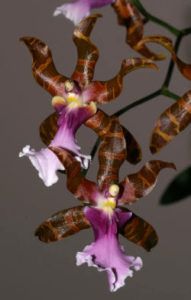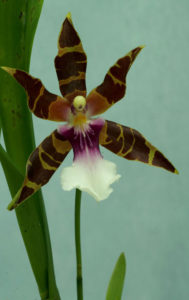The following article was written for the Orchid Species Bulletin published by the Orchid Species Society, which is based in Brisbane, Queensland in April 2011.
Bear in mind that any cultivation notes refer to the subtropical conditions of Southern Queensland, Australia.
 Miltonia clowesii Lindl. was first discovered by George Gardner in the Organ Mountains near Rio de Janeiro, Brazil. Gardner sent plants to Rev. John Clowes of Manchester, England who was the first to flower it in Europe, in 1839. John Lindley named it in Clowes’ honour in Sertum Orchidacearum that same year.
Miltonia clowesii Lindl. was first discovered by George Gardner in the Organ Mountains near Rio de Janeiro, Brazil. Gardner sent plants to Rev. John Clowes of Manchester, England who was the first to flower it in Europe, in 1839. John Lindley named it in Clowes’ honour in Sertum Orchidacearum that same year.
Milt. clowesii is an epiphytic plant that has narrowly oblong-ovate compressed pseudobulbs. Borne along a creeping rhizome at 2.5-4 cm intervals, the olive green pseudobulbs are 7.5-10 cm long. The pseudobulbs are about 2 cm across near the base and taper to 1 cm near the apex. The pseudobulbs are subtended at the base by 2-4 leafy bracts. At the apex of the pseudobulbs are two thin light yellow-green, linear to tongue-shaped leaves that are 22-65 cm long and 1.8-2.5 cm broad. The upright to spreading raceme is produced from the base of the pseudobulb and emerges from within the inner basal leaf sheath. Varying from 22-65 cm long, the raceme bears 5-10 flowers that open quickly in succession so that several blooms are usually open at one time.

Sweetly scented during the day, the long-lasting showy flowers of Milt. clowesii are variable in colour and are 5-6 cm across and 7-8 cm long. They have yellowish brown to yellow-orange sepals and petals that are heavily barred or blotched with maroon to chestnut-brown. The white to cream-yellow fiddle-shaped lip is violet-purple to deep mauve towards the basal half and the callus of 5-7 raised keels is white to yellow. Sometimes the colour of the lip may change from white to yellow as the flowers age, so that the raceme carries different coloured blooms.
Endemic to Brazil, Milt. clowesii is found in the cooler mountains of Rio de Janeiro, Espírito Santo and Minas Gerais. Jim and Barbara McQueen (1993) recommend intermediate conditions with moderate to bright indirect light for this species. Give it plenty of water during the warmer months while it is growing, then a drier winter rest. Due to its rambling habit is is best grown in a shallow tray or basket. Plants may also be mounted on cork bark, hardwood or tree fern but may need daily watering or misting during the hotter months of the year.
